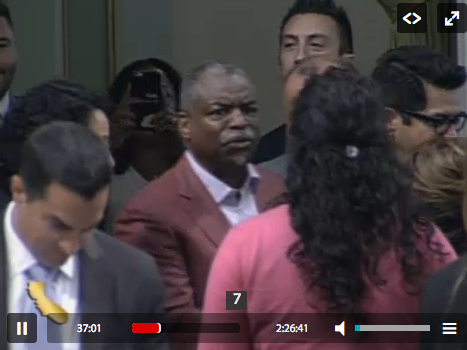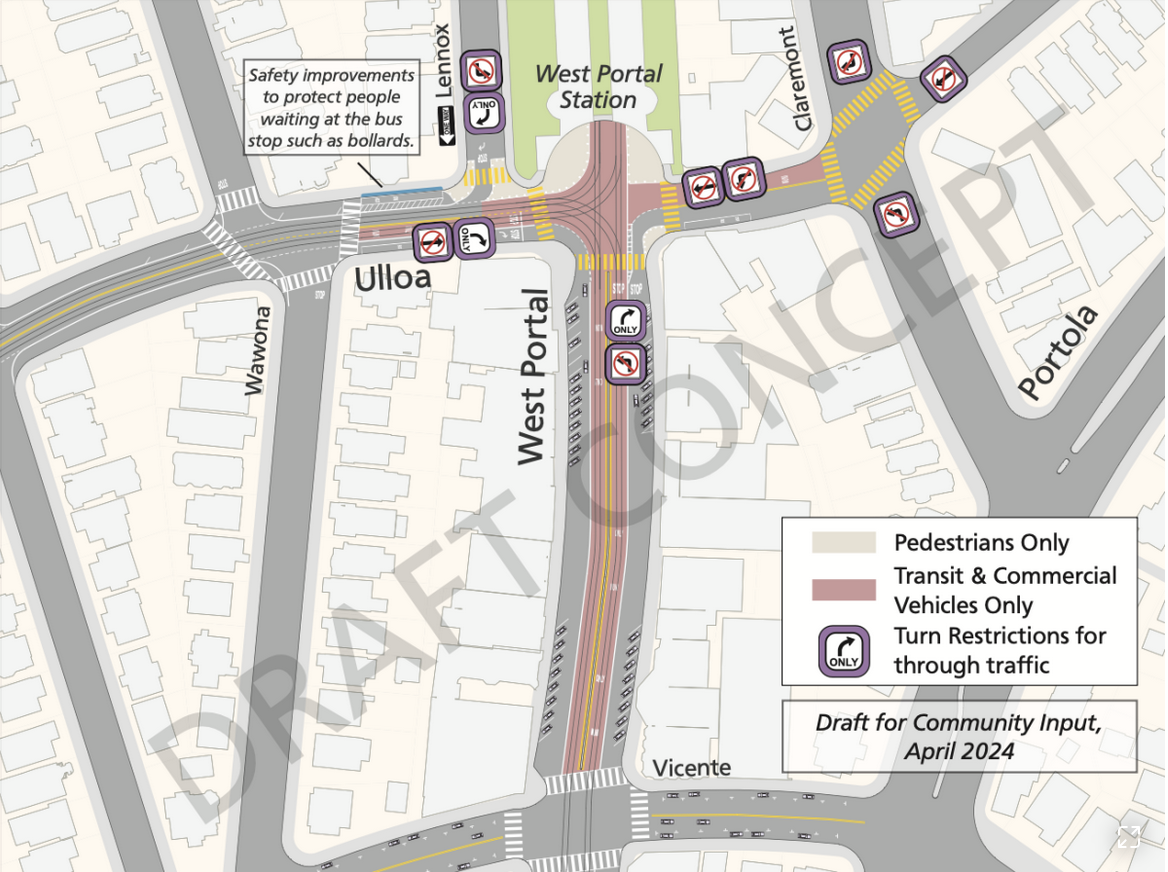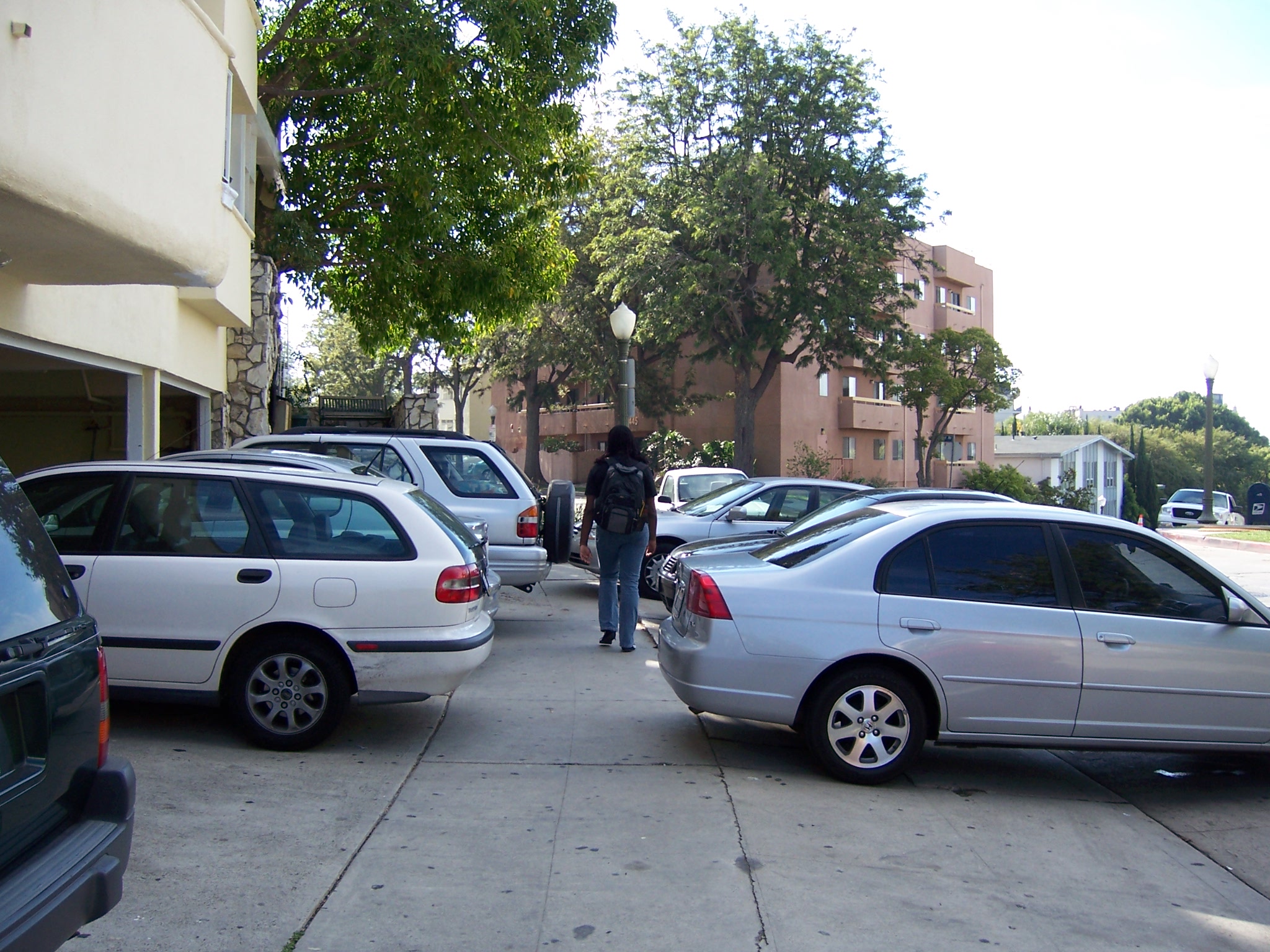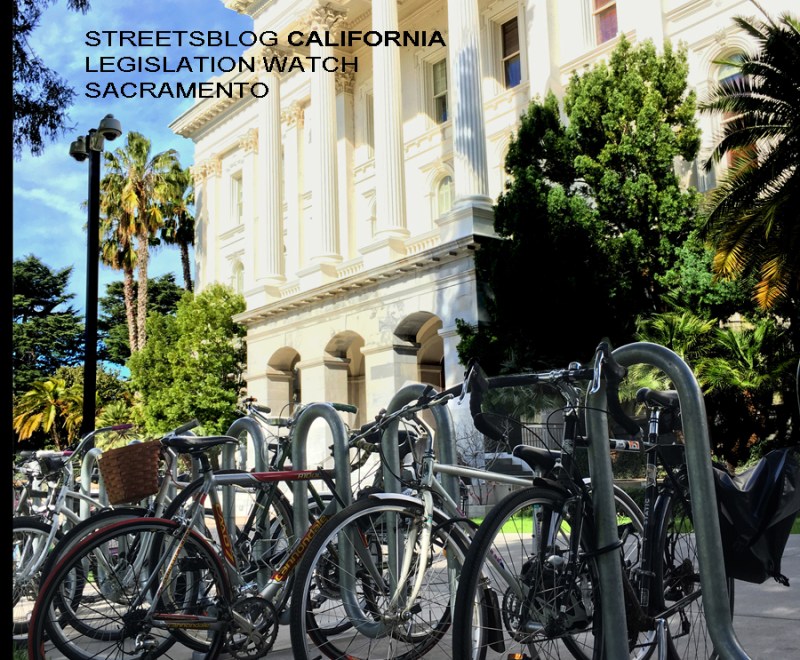Legislative Wrap-up: Environmental Justice, Cap-and-Trade Funding
1:02 PM PDT on September 1, 2016

The lead-up to the end of the California legislative session at midnight last night included a standard amount of grandstanding, tearful farewells, laughter, and exhaustion. Some bills passed and will now await the governor's good graces, and some died on the legislature floor. Here's a quick recap of a few bills relevant to sustainable streets. Details on each follow:
Passed, await governor's signature:
- S.B. 1000: Environmental justice in General Plans
- A.B. 1550: Greenhouse gas reduction investment in disadvantaged and low-income communities
- S.B. 1613: GGRF funding allocation plan
- A.B. 2722: Transformative climate communities grants
Failed:
- S.B. 1387: Community representatives on South Coast Air Quality Management District Board
Environmental Justice in General Plans
Senator Connie Leyva's bill that would require local planning to incorporate consideration of environmental justice, S.B. 1000, passed the Senate floor late in the evening, after being held up briefly in the Assembly by politics.
Leyva had angered legislative leaders earlier in the session when she endorsed an Assembly colleague's opponent in the upcoming Senate race. For a while yesterday it looked like her bill, which has the potential to profoundly improve planning in California, could fall victim to repercussions of her stance.
But in the end it passed. A few Republicans, including Senator Jim Nielsen (R-Tehama) got up to complain that the bill would undercut local control, that it “broadened the opportunity for litigation,” and that having to incorporate “so-called environmental justice” into General Plans would be costly for cities. The final vote was 25 to 13 in favor.
This bill has the potential to profoundly improve planning in California for everyone. Not only would it require cities to think and talk about which of its communities are at a disadvantage because of past planning decisions, it would make them come up with ways to involve the people in those communities in making future planning decisions. While good public engagement is without a doubt a challenge to encourage and manage, it is also something city planners need to do anyway.
Justice on the South Coast Air District Board
Another environmental justice bill we wrote about yesterday did not fare so well. S.B. 1387 from Senate President Pro Tem Kevin de Leon (D-Los Angeles) would have added local residents to the South Coast Air Quality Management District Board, thus giving them a voice in decisions made by that board. In the end, the bill failed in a vote on the Assembly floor, with Republicans voting against it and claiming that the bill was an attempt by the state to wrest away local control.
But what really undid the bill was the large number of Democrat Assemblymembers who sat out the vote entirely, including Luis Alejo (D-Salinas), Joaquin Arambula (D-Fresno), Ian Calderon (D-Whittier), Kansen Chu (D-San Jose), Jim Frazier (D-Oakley), Eduardo Garcia (D-Coachella), Mike Gipson (D-Gardena), Richard Gordon (D-Menlo Park), Adam Gray (D-Merced), Roger Hernández (D-West Covina), Chris Holden (D-Pasadena), Kevin Mullin (D-San Mateo), Patrick O'Donnell (D-Long Beach), and Shirley Weber (D-San Diego).
One legislative staffer believed that at least some of these legislators withheld their votes because they expect a change on the board soon, which would moot the point of the bill for them. Another concern with the bill was that adding three new members would mean the board would end up with an even number of votes, which could lead to problems if there were a tie.
Equity in Greenhouse Gas Investments
A third environmental justice bill, A.B. 1550 from Assemblymember Jimmy Gomez (D-Los Angeles), passed the Assembly with a 53-22 vote. The bill would require 25 percent of the money the state is investing in reducing greenhouse gases to be used to benefit disadvantaged communities. Floor speeches about it were mainly about the limitations of CalEnviroScreen, which is the tool used by the state to officially designate communities as “disadvantaged” for funding purposes. Some have complained that the CalEnviroScreen results, since they focus mainly on environmental factors, have unfairly excluded some communities from the definition of “disadvantaged.”
You might not think cities would want to be disadvantaged, but it can be a huge advantage to be disadvantaged when it comes to applying for state funding.
Gomez's bill steps around this controversy by calling for at least ten percent of the cap-and-trade funds to be invested in a way that benefits low-income communities anywhere in the state, whether they are officially considered “disadvantaged” under CalEnviroScreen or not.
“These communities have served as dumping grounds for industrial pollution. They are located next to highways, and are disproportionaly home to Latinos and African Americans,” said Gomez. “We can turn these red hot spots into green zones... This bill is an improvement over the status quo, and a framework for low-income communities that we can build on in the future.”
Assemblymembers Rich Gordon (D-Menlo Park) and Phil Ting (D-San Francisco) both addressed the CalEnviroScreen controversy. “I've struggled with CalEnviroScreen,” said Gordon. “Forty percent of our low income communities don't qualify as disadvantaged communities,” he said. “Hopefully we can continue this discussion.”
“The bill is not as good as it was when it left the Assembly,” said Ting, “but it is still good. We need to continue improving the definition” so that it incorporates low-income communities.
Greenhouse Gas Reduction Fund Allocations
Gomez's bill was attached to S.B. 1613, the budget bill that allocates the portion of cap-and-trade funding that is not already allocated by formula. That bill was negotiated in the last few days between Assembly and Senate leaders, and ended up passing on both floors yesterday.
In the end, the bill allocated the amount of money currently in the Greenhouse Gas Reduction Fund thusly:
- $10 million to the Active Transportation Program. This is the first time the Active Transporation Program has received any money from the Greenhouse Gas Reduction Fund, even though getting people to ride bikes and walk rather than drive cars is arguably the most cost-effective way to reduce greenhouse gases. $10 million is not as much as advocates had hoped for, but it's a good start.
- $135 M to the Transit and Intercity Rail Capital program (so, no money for transit operations, which are sorely needed)
- $80 M to urban greening programs
- $2 M for technical assistance in disadvantaged communities, to help them develop projects and programs to reduce GHGs
- $140 M to a new Transformative Climate Communities program (see below)
- $40 M to forestry and fire protection
- $130 M to the Clean Vehicle Rebate Program
- $80 M to the Enhanced Fleet Modernization Program and the Plus-Up Pilot project (which aim to make electric vehicles accessible to low-income drivers)
- $150 M for clean heavy duty and off-road equipment
- $5 M to black carbon woodsmoke programs
- $40 M for recycling
- $20 M for weatherization
- $50 M for methane emissions reductions from dairy and livestock operations
- $7.5 M to the Healthy Soils Program
- $7.5 M for water efficiency
The Transformative Climate Communities program, created by A.B. 2722, also passed yesterday. This bill from Assemblymember Autumn Burke (D-Inglewood) calls for grants to be made “for the development and implementation of neighborhood-level transformative climate community plans that include greenhouse gas emissions reduction projects that provide local economic, environmental, and health benefits to disadvantaged communities.” Its promise is to tap into the creative energies of local communities, and it is one of the bills passed this session that have the potential to involve more people in solving the pressing problems of climate change, transportation, and maybe even housing.
Several bills that could make it easier to build more housing also passed in the last hours of the session—but this is enough for now. More on those later.
Email tips, alerts, press releases, ideas, etc. to melanie@streetsblog.org.
For social media coverage focused on statewide issues, follow Streetsblog California @streetsblogcal on Twitter, or like our Facebook page here.
Streetsblog California editor Melanie Curry has been thinking about transportation, and how to improve conditions for bicyclists, ever since commuting to school by bike long before bike lanes were a thing. She was Managing Editor at the East Bay Express, editor of Access Magazine for the University of California Transportation Center, and earned her Masters in City Planning from UC Berkeley.
Stay in touch
Sign up for our free newsletter
More from Streetsblog California
Automated Enforcement Coming Soon to a Bus Lane Near You
Metro is already installing on-bus cameras. Soon comes testing, outreach, then warning tickets.
Friday’s Headlines
SF plans street redesign at crash site; Santa Cruz commission still supports plan to have both trail and rail; State budget includes subsidies for fossil fuel industry; Unhoused camping; More
Thursday’s Headlines
CA youth speak out on climate: How LA Metro plans to spend $ from canceled 710 freeway; Watch out, illegal SF parkers, tickets are coming; More
Legislators Tackle AV, School Zone Safety
Are AVs freight trucks ready to be deployed on California roads with no one in them?
Metro Looks to Approve Torrance C Line Extension Alignment
Selecting the relatively low-cost hybrid alternative should help the oft-delayed South Bay C Line extension move a step closer to reality




